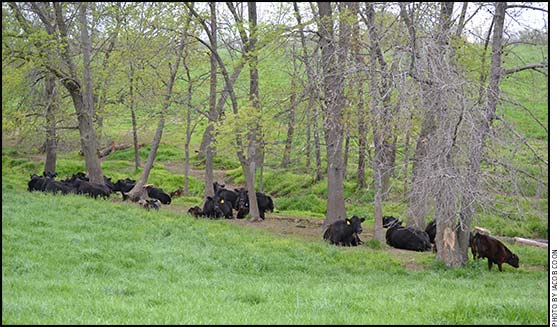
Prepare Cows for Spring Calving
Three tips to set your herd up for a successful calving season.
Spring calving is just around the corner, providing the promise of a new calf crop and excitement for the future. Steps taken today can set cows up for a successful calving season. However, poor preparation has a direct impact on the health and well-being of those calves, as well as the future reproductive performance of the herd, says Ted Perry, beef nutritionist with Purina Animal Nutrition LLC.
For an optimal calving season, Perry recommends that producers focus on three areas: body condition scores, mineral programs and the area where cows will calve.
“Implementing a few strategies ahead of the calving season can make calving programs successful,” he says, adding that with today’s beef prices producers can’t afford to lose any calves.
Body condition scores
The ideal body condition score (BCS) at calving is a 6 on a 9-point scale.
“Being at the ideal BCS is probably the most important thing beef producers can do prior to calving,” says Perry. “It’s not hard to slip down to a body condition score of a 4 or 5, and think it’s no big deal. But anything less than a 6 spells trouble.” Keeping the cows in good body condition all year can pay huge dividends on individual calf and herd performance.
Cows with low body condition scores are at risk for more calving problems. Their calves may be weaker and not as vigorous, which means they are less likely to get up and drink colostrum in the first few hours after birth.
Perry says that low BCS numbers could be a common problem this year as beef producers are trying to get through winter with low forage supplies. Fortunately, it’s not too late to increase a cow’s BCS. “Getting your body condition scores up to a 6 by calving will pay dividends,” he says, explaining that an adequate ration with protein, energy and mineral supplements can set cows up for a successful season.
For more on body condition scoring, visit the Angus Journal’s topic site devoted to the subject at www.cowbcs.info.
Mineral program
Having a good nutrition and mineral program in place is essential for a variety of reasons, including better response to vaccinations and colostrum quality for the calf, which provides immune protection. “The ideal body condition score prior to calving coupled with a good mineral program can translate into good quality colostrum and calves that are better protected from the start,” says Perry.
He explains that, from mid-gestation to late-gestation, there will be an increase of about 20% to 25% for protein and mineral needs by the cow. Nutritional needs increase again as the cow gets closer to calving, increasing by more than 60% for minerals and 25% energy and protein between late gestation and calving. Meeting these nutrient requirements is critical to calf growth in utero and the cow’s ability to care for the live calf.
For more information on mineral nutrition for the cow herd, read “Mineral Mystery,” to be published in the February Angus Beef Bulletin, or review the summary, proceedings, PowerPoint and audio for Cody Wright’s presentation at the 2012 Applied Reproductive Strategies in Beef Cattle Symposium available at www.appliedreprostrategies.com/
2012/SiouxFalls/newsroom.html#Wright.
Clean calving area
Providing a clean environment for cows to calve in is a simple but effective recommendation for successful calving. “The cleaner the calving environment the better,” says Perry.
Perry recommends keeping cows out of the calving area for 30-45 days prior to calving to reduce the amount of manure in the area.
“If you are using the barn to provide shelter, consider reducing the amount of space allotted to the cows, and save a portion for calving time,” he says. “Providing a clean and dry environment for calves will go a long way in protecting the future of your herd.”
Keeping these three recommendations in mind when preparing for calving season can help better prepare cows for the upcoming season.
“There are a lot of newborn calf management practices out there, but nothing trumps a cow with an optimal body condition score that’s fed the correct mineral program before calving into a clean environment,” says Perry.
Editor’s Note: This article is adapted from a news release provided by Purina Animal Nutrition LLC.
[Click here to go to the top of the page.]












